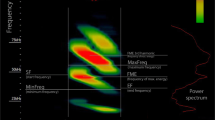Summary
-
1.
Audiograms are recorded from one non-echolocating and nine echolocating sympatrically living bat species of South India. These species areCynopterus sphinx (non-echolocating),Tadarida aegyptiaca, Taphozous melanopogon, T. kachhensis, Rhinopoma hardwickei, Pipistrellus dormeri, P. mimus, Hipposideros speoris, H. bicolor andMegaderma lyra.
-
2.
InRhinopoma hardwickei a highly sensitive frequency range was found which is narrowly tuned to the frequency band of the bat's CF-echolocation call (32–35 kHz, Fig. 3). In hipposiderids a ‘filter’ narrowly tuned to the frequency of the CF-part of the CF-FM echolocation sounds (137.5 kHz inH. speoris and 151.5 kHz inH. bicolor, Fig. 5) could be recorded from deeper parts of IC.
-
3.
In the echolocating species the best frequency of the audiograms closely matched with that frequency range in the echolocation calls containing most energy.
-
4.
In bat species foraging flying prey best frequencies of audiograms and height of preferred foraging areas are inversely related, i.e. bat species hunting high above canopy have lower best frequencies than those foraging close to or within canopy (Fig. 6).
-
5.
A hypothesis is forwarded explaining how fluttering target detection by constant frequency echolocation might have evolved from long distance echolocation by pure tone signals.
Similar content being viewed by others
Abbreviations
- BFA :
-
best frequency of audiogram
- b.w. :
-
body weight
- CF :
-
constant frequency
- FM :
-
frequency modulated
- IC :
-
inferior colliculus
- SPL:
-
Sound Pressure Level
References
Busnel RG, Fish J (eds) (1980) Animal sonar systems. Plenum Press, New York
Fiedler J (1979) Prey catching with and without echolocation in the Indian False Vampire (Megaderma lyra). Behav Ecol Sociobiol 6:155–160
Grinnell AD (1970) Comparative auditory neurophysiology of neotropical bats employing different echolocation signals. Z Vergl Physiol 68:117–153
Grinnell AD, Brown P (1978) Long-latency ‘subthreshold’ collicular responses to the constant-frequency components emitted by a bat. Science 202:996–999
Grinnell AD, Hagiwara S (1972a) Adaptations of the auditory nervous system for echolocation. Z Vergl Physiol 76:41–81
Grinnell AD, Hagiwara S (1972b) Studies of auditory neurophysiology in non-echolocating bats, and adaptations for echolocation in one genus,Rousettus. Z Vergl Physiol 76:82–96
Habersetzer J (1981) Adaptative echolocation sounds in the batRhinopoma hardwickei. J Comp Physiol 144:559–566
Habersetzer J (1983) Ethoökologische Untersuchungen an echoortenden Fledermäusen Südindiens. Doctoral thesis. Fachbereich Biologie, University of Frankfurt
Jen HS, Suthers RA (1982) Responses of inferior colliculus neurons to acoustic stimuli in certain FM and CF-FM paleotropical bats. J Comp Physiol 146:423–434
Lawrence BD, Simmons JA (1982) Measurements of atmospheric attenuation of ultrasonic frequencies and the significance for echolocation by bats. J Acoust Soc Am 71:585–590
Long GR, Schnitzler HU (1975) Behavioural audiograms from the bat,Rhinolophus ferrumequinum. J Comp Physiol 100:211–219
Miller LA, Degn HJ (1981) The acoustic behavior of four species of vespertilionid bats studied in the field. J Comp Physiol 142:67–74
Neuweiler G (1970) Neurophysiologische Untersuchungen zum Echoortungssystem der Großen HufeisennaseRhinolophus ferrumequinum. Z Vergl Physiol 67:273–306
Neuweiler G, Bruns V, Schuller G (1980) Ears adapted for detection of motion, or how echolocating bats have exploited the capacities of the mammalian auditory system. J Acoust Soc Am 68:741–753
Schuller G (1980) Hearing characteristics and Doppler shift compensation in South Indian CF-FM bats. J Comp Physiol 139:349–356
Author information
Authors and Affiliations
Rights and permissions
About this article
Cite this article
Neuweiler, G., Singh, S. & Sripathi, K. Audiograms of a South Indian bat community. J. Comp. Physiol. 154, 133–142 (1984). https://doi.org/10.1007/BF00605398
Accepted:
Issue Date:
DOI: https://doi.org/10.1007/BF00605398




